The main requirement for electrical wiring is safety. It is impossible to allow a short circuit to occur during operation, which can lead to disastrous consequences and even fire, therefore all wire connections are protected by heat shrink or electrical tape. We recommend that you use large diameter heat shrink tubing during assembly junction boxes, and not electrical tape, which eventually dries out and unwinds, exposing the wires.
Heat shrink is a flexible thin tube, made of a polymer material that contracts linearly with increasing temperature.The main advantages of the polymer over the insulating tape:
- High density and homogeneity of the material. Heat-shrink tubing perfectly insulates the surface of the wires, “soldering” the insulation. It does not unwind and does not slip, unlike electrical tape.
- Installing the tube is easier than conventional tape. Just put it on the contact and heat it with a hair dryer or a lighter.
- Long service life. The polymer is not afraid of moisture or ultraviolet, it does not disintegrate over time, serving 30-50 years without loss of quality and shape.
When heated, the polymer shrinks and tightly fits the wires, protecting the place of twisting or soldering. Similar the connection will be tight and durable, protected from oxidation and short circuit . The only thing you need is to choose the right, so that the polymer isolates the contacts and cables as much as possible.
Purpose of the product
Heat shrink tubing was originally used to insulate and protect wires, but it has found many different uses. We will talk about this a little later, but now we will consider what goals can be achieved using it in everyday life:
- Protection of any connections from moisture and water leaks. For example, you can connect two pipes or a junction of a pipe and a battery.
- Protection of connections from ultraviolet, dirt, mechanical damage, corrosion. Since the tube does not allow moisture to pass through, rust does not begin under it and corrosion does not occur.
- Surface protection from chemicals. The polymer is not afraid of contact with aggressive media.
- Protecting the surface or joints from deformation.
- Ability to repair cuts and other defects in cable insulation, insulation of wires and connections.
- Wire marking in different colors.
The material is used wherever there are wires and cables - in car repair, wiring, restoration household appliances and various electrical equipment. It is used when installing alarms or head units on cars, protecting hose connections with filters or other devices, used in plumbing, etc. A wide range of colors and heat shrink tubing diameters opens up great opportunities for the repair and insulation of various surfaces.
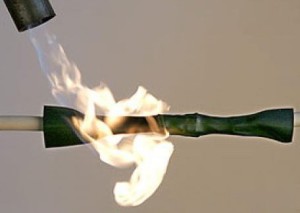 Wide range of colors of heat shrink tubing
Wide range of colors of heat shrink tubing Material Properties
The main properties of the polymer tube include:
- The ability to shrink by 100-600% when the temperature rises from 70 to 120 degrees. When repairing electronics, fusible tubes with a compression temperature of 70 degrees are usually used, in cars 125-130.
- Ability to withstand sudden changes in temperature. The tube can be operated in damp and unheated rooms or outside buildings, it operates in the range from -45 to +130 degrees.
- Due to the addition of dyes to the polymer, it is given different colors, which makes it possible to mark cables. The default color is black, but stocks are available in red, yellow, blue, green, and more. There are even transparent tubes - they allow you to monitor the state of the connection.
Material characteristics
let's consider main features of heat shrink tubing:
- The possibility of compression (shrinkage ratio) from 100 to 600 percent of the original size.
- Wide range of colors to control groups of wires.
- The possibility of waterproofing and sealing joints due to the presence of an adhesive composition in the product. When heated, the adhesive spreads over the surface, and then hardens and turns into a single whole with the cable, reliably isolating it.
- Good resistance to solar radiation, temperature extremes, technical oil and gasoline, acids and alkalis.
Heat shrink is made from special polymers. Depending on the purpose, it can use polyvinyl chloride, polyolefin, elastomer, etc. There are self-extinguishing polymers, polymers for high loads, for hermetic joints, for bending surfaces, etc.
 Heating the tube with a hair dryer
Heating the tube with a hair dryer Terms of Use
Despite the fact that manufacturers recommend “activating” their products with a special hair dryer, in most cases no special installation equipment is needed. The tube is simply put on the wires or the surface, after which it is gently warmed up by the fire from the lighter. Heat shrink tube shrink temperature - about 70-100 degrees, it immediately begins to shrink and tightly fits the surface. The main thing is not to overdo it and not burn it, drive the flame over the polymer carefully and over the entire plane. A hair dryer is good because it heats the air to a predetermined temperature and evenly heats the surface without causing a fire, but it is not possible to use it everywhere. In addition, it is quite expensive and bulky, so the vast majority of electricians and installers use lighters.
The only difficulty of the installation lies in the correct selection of the diameter and the degree of compression of the material.
Attention:non-linear compression of the tube is allowed. For example, you need to insulate two wires with a diameter of 3 mm, connected by a terminal with a thickness of 6 mm. You need to choose a heat shrink with an inner diameter of 8-10 mm and a shrink ratio of 4:1 or 6:1. When heated at the terminal, the tube will shrink less, and more on the wires.
The main thing is that the fully compressed tube should not be larger than the diameter of the wires, so it is not necessary to insulate the cable 1.5 mm2 with 20 mm heat shrink. With an actual thickness of wire with insulation of 3 mm, take an 8-10 mm pipe. There is no need to strive to select diameters with a minimum margin - the more you compress the product, the thicker the insulating layer will be and the higher the strength of the polymer.
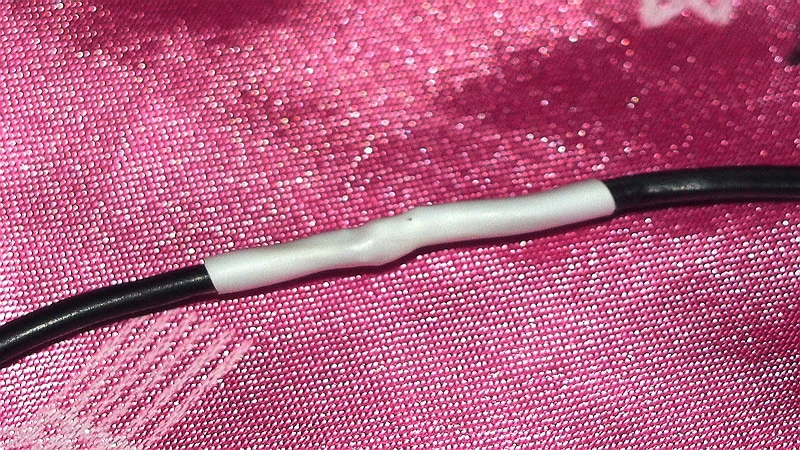 This is what an insulated wire looks like
This is what an insulated wire looks like Installation rules
Consider an example of connecting a cable consisting of two wires of 2.5 squares. The actual diameter of one wire with insulation is 4 mm, the diameter of the cable is 10 mm.
Important:when connecting two wires, separate the connection points 3-5 cm apart. This will avoid a short circuit in the event of a thermal insulation break.
This can be done quite simply - you make one wire shorter, the second longer, on the other side of the cable, vice versa. You connect a long one with a short one (the connection is best done with a terminal or by soldering a twist), a short one with a long one. As a result, you will get two connections, separated from each other by several centimeters.
You already know everything you need to know aboutso you can pick them up yourself. Before twisting the wires, you put heat shrink on each piece. Keep in mind that when heated, it will “dry out” by 7-10 percent. In our case with 4 mm wires, we take a tube with a diameter of 10 mm, we put a 20 mm shrinkage on the cable itself. First we twist the two wires (connect them by color so as not to get confused, that is, brown with brown, blue with blue), then move the heat shrink so that it closes the connection, and heat it with a lighter until it tightly wraps around the wire. We repeat the operation with the second one, and then we isolate the junction from above with the last thick tube.
Warming up is recommended to be done either from the middle to the edges, or from one edge to the second. No need to first “solder” the two edges, and then heat the center - air will accumulate inside, which will prevent the cable from being well insulated.
 The tube can take on a variety of shapes
The tube can take on a variety of shapes The length of the tube should be chosen so as to create insulation on each side of the connection by 30-50 mm. In this case, consider shrinkage by 10 percent. The thicker the cable, the wider the insulation - our 10 mm can be protected 5-7 cm in each direction.
When heating the polymer, be prudent. You do not need to heat one place for a long time - try to drive the lighter over the entire surface, evenly warming it up. When the polymer begins to shrink, smooth it with your fingers - it will not burn the skin. It is necessary to exclude the appearance of air bubbles under the PVC. If heat shrink with glue is installed on the cable, then the surface is recommended to be degreased and cleaned of dust. Working with the material for the first time - practice on wire scraps. You will understand how to properly heat, from which side to start shrinking, how to properly level it.
Dimensions
When buying heat shrink for wires, consider the size and diameter of the tubes. All manufacturers put markings on them so that the buyer can immediately determine the size he needs. It is the inner diameter that is indicated, so you do not need to calculate the proportions.
If you see the inscription 10/3, then it means that the inner diameter is 10 mm, after shrinkage it shrinks to 3 mm. Sometimes the compression ratio is simply indicated (in our case it will be 3:1).
American and European manufacturers write the diameter in inches, so you will need to recalculate the size based on the fact that 1 inch equals 25.4 mm. Everything is simpler for Russian and Asian manufacturers - they indicate it in mm.
In stores, products are sold in lengths of 1000 mm, although at wholesale they are bought in bays of 50-100 meters, after which they are cut to the desired size.
Now consider the types of heat shrink:
- Thin-walled, adhesive-free, compression ratio up to 4:1. These are the most common materials that form insulation up to 1 mm thick. Produced in various color scheme, are inexpensive. They are not afraid of ultraviolet radiation and temperature changes, they have self-extinguishing properties.
- Having thick walls, during shrinkage they form an insulating layer 1-4 mm thick. Usually contain an adhesive composition, allow you to waterproof the surface. With a shrinkage ratio of up to 6:1, they are suitable for insulating pipes, power cables, making bundles, etc.
There is nothing complicated in installing heat shrink - with practice, you can make neat and tight connections on any surface. It is advisable to clean it from dirt and dust before shrinking in order to improve the effect.
Heat-shrinkable tubing (abbreviated as HERE) was invented back in the 50s of the last century. It was obtained due to a change in the molecular structure of polymers.
They call it differently: heat-shrinkable, heat-shrinkable, thermocambric or simply a thermotube. This does not change the essence, since they are all the same products.
Its main task is to isolate contacts, but besides this, there are additional ways to use such devices:
- shrinkage on the butt of a wooden or metal rack of a power transmission line support to protect against corrosion and decay of wood in the ground
- isolation from aggressive environment of metal and water pipes


![]()

The use of heat shrink is based on the shape memory effect. It is achieved by radiation exposure.
If, for example, a polymer is placed in a powerful electron flow, then molecular level neighboring macromolecules are joined together. This technology is called cross-linking technology.
The polymer itself after this operation becomes more elastic, and the product, when heated, acquires its original shape and original dimensions. 
Theoretically, the same tube can be seated an infinite number of times. If you had a device for heating and inflating it, then it would turn into a reusable product. Moreover, the period of its storage in its original state for decades. All characteristics and quality of the product, subject to certain requirements, do not depend significantly on the date of manufacture.
To date, heat shrinkable tubing has gained enormous commercial and technical importance throughout the world. However, the main areas of application remain the fields of electronics and electrical engineering. 
Thermotubes are much more efficient than conventional cambric tubes, which are branded TV-40. In addition to technical resistance, they also have chemical resistance. And this allows you to reliably protect the insulation and contacts in places with aggressive environments - underground, in wells, cable channels.
Types of heat shrink
Here are the main types of heat-shrinkable tubes widely used in everyday life and industry (from KBT), their dimensions and characteristics:
Heat shrink tube TUTng 2k1Transparent tube KST 2k1Colored tubes HERE 2k1Yellow-green TUTng w-z

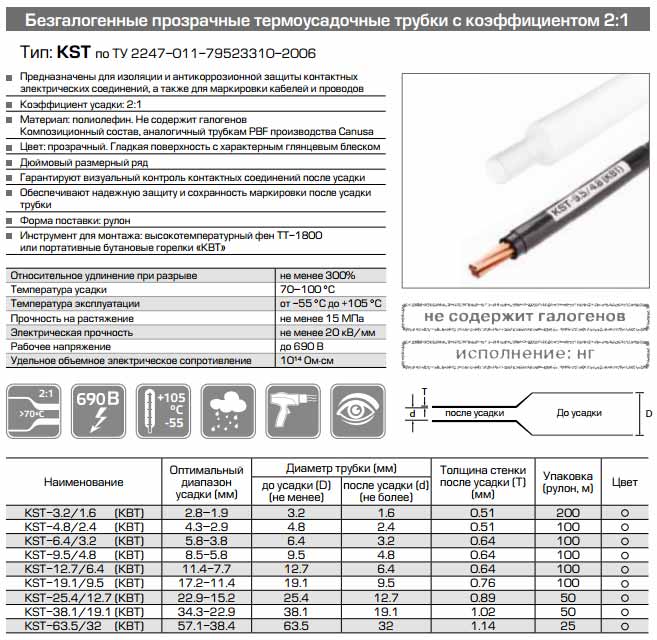
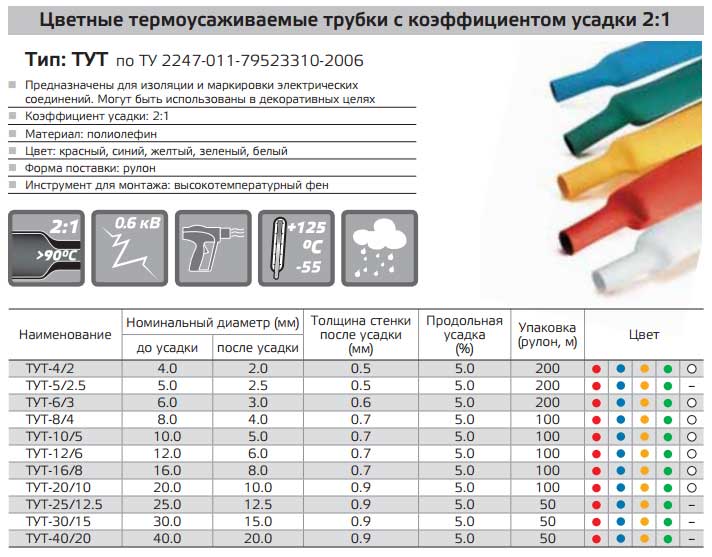
 Yellow-green heat shrink tubing TUTng zh-z
Yellow-green heat shrink tubing TUTng zh-z
Thick-walled and high-voltage heat shrink brands:
Thick-walled TST 3k1Anti-tracking TST-A 3k1Thick-walled non-combustible TT-S ngHeat-shrinkable tape TLC-10Tube for tires 10kv TTSh-10Tube for tires 35kv TTSh-35
![]() Thick-walled TST 3k1
Thick-walled TST 3k1
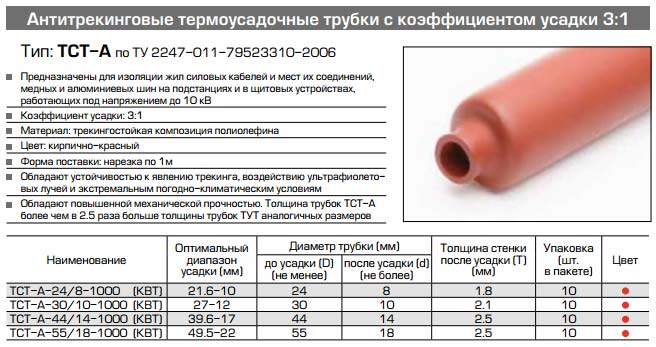
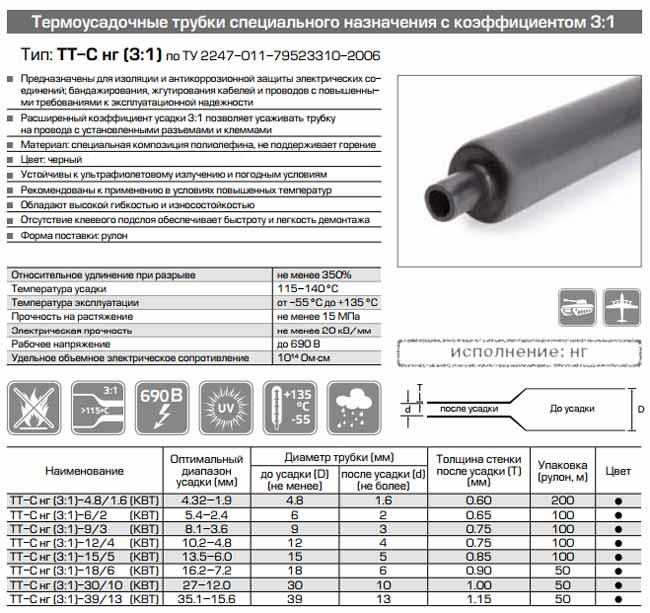
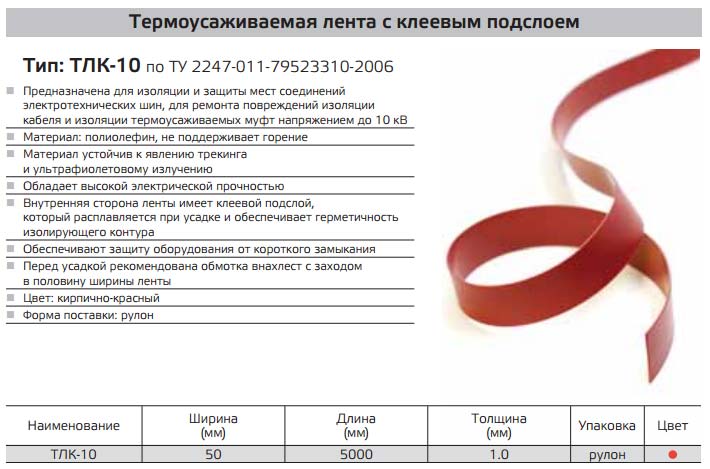



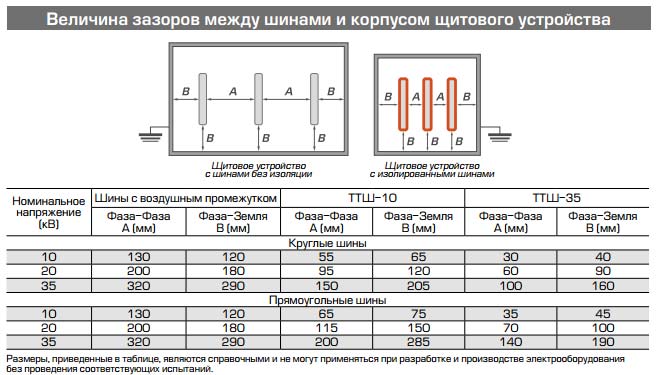
Heat shrinks of special execution:
Repair cuffsReinforced cuffs Cable caps Heat shrink 6k1 Casing With adhesive layer TTKMedium-wall STTK
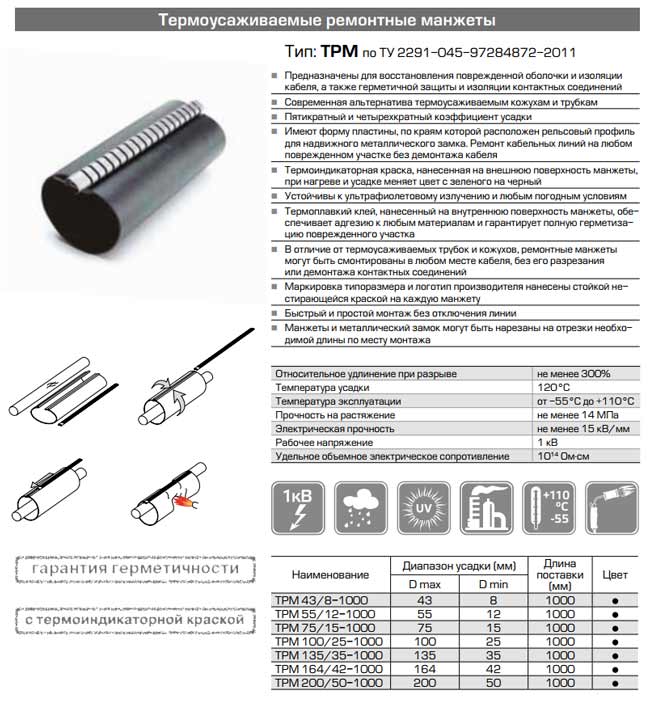


![]()
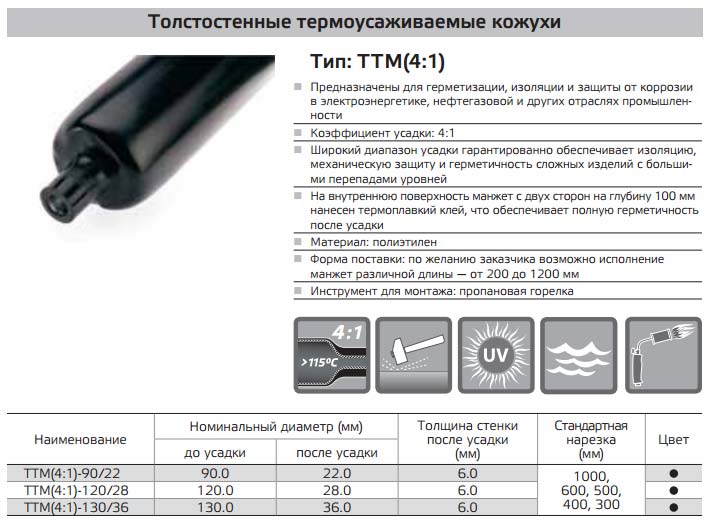
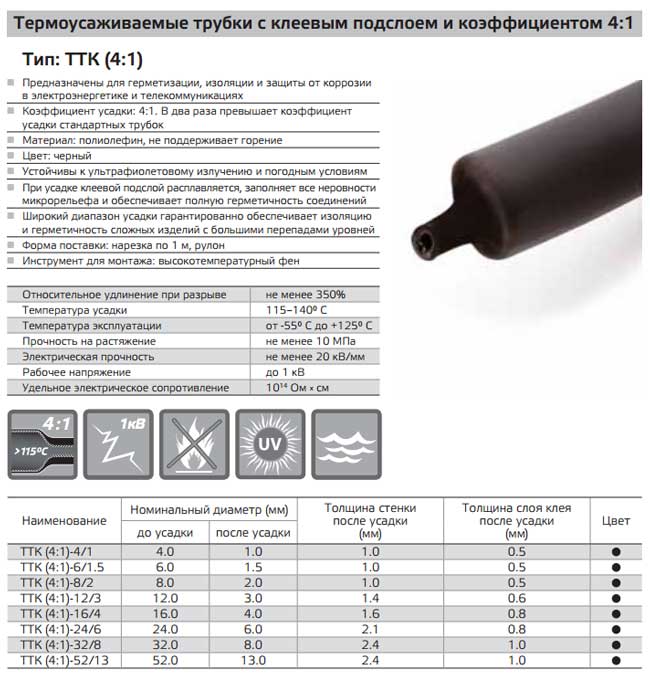

Characteristics and differences
What are heat shrinks and how do they differ from each other?
diameter before and after
Heat shrink tubing changes diameter when heated. Therefore, the name should always contain the size BEFORE and AFTER shrinkage. 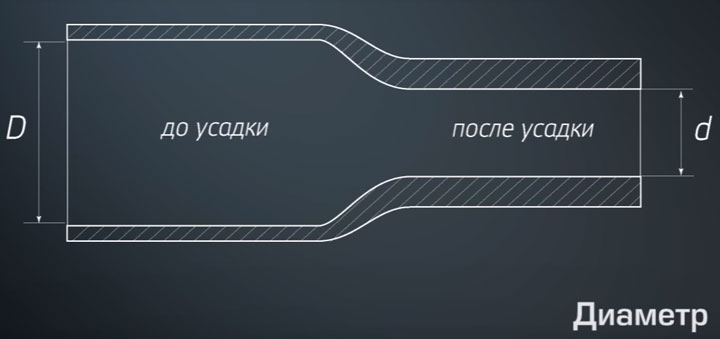
For example tube HERE NG 40/20
- inner diameter 40mm - DO
- total shrinkage diameter 20mm - AFTER
Shrinkage ratio
The next criterion is the shrinkage factor. What it is? This is the ratio of the primary diameter to the diameter after the shrinkage process. That is, depending on the coefficient, the tube decreases several times. There are coefficients:
- 2 to 1
- 3 to 1
- 4 to 1
- 6 to 1
The larger it is, the more difficult it is to make the product. As a result, their prices also differ significantly. However, 4 to 1 tubes are considered more versatile than 2 to 1 tubes.
If you connect two wires of different sections and different thicknesses, without heat shrinkage with large coefficients. you can't do it. 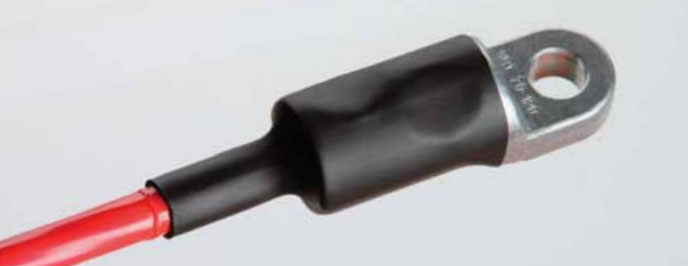
Wall thickness
Thermotubes can have different wall thicknesses. According to this criterion, they are divided into:
- thin-walled
- mid-wall
- thick-walled
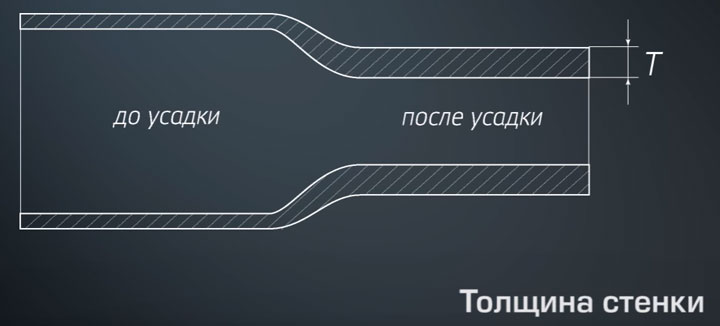
In addition, the thermotube can be glued - TTK brand. This is the one on the inner surface of which a layer of hot melt adhesive is applied. When heated, the adhesive melts and fills all microvoids, thereby ensuring a complete seal. 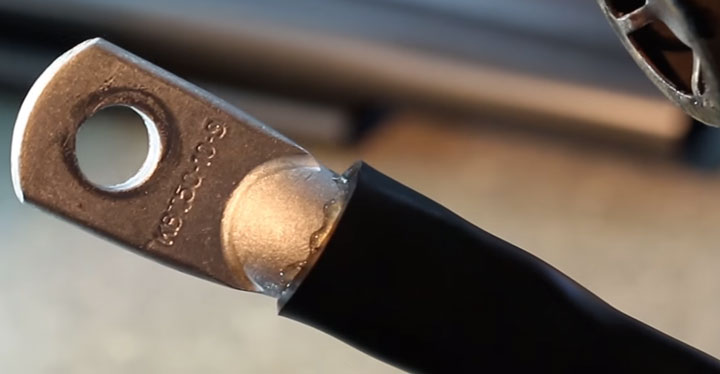
Walls stick to almost any surface. Excess glue should come out at the edges.
It will not work to replace such a hot-melt adhesive by first coating the inner walls of a simple tube. It is applied during its manufacture. In addition, the adhesive coefficient of heat shrinkage is greater than that of the usual one - 3 * 1 or 4 * 1 versus 2 to 1. And it can also be designed for greater stress, due to the wall thickness. 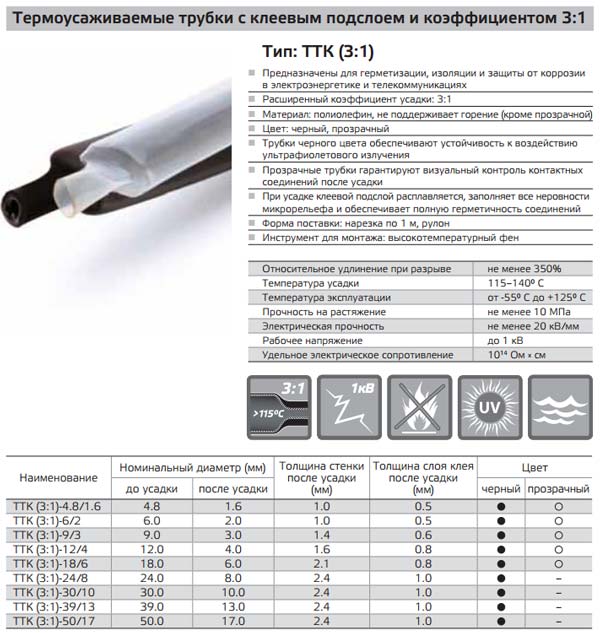
non-combustible
Of great importance is the material from which the product is made. It is thanks to the composition of the composition of this material that the desired properties are predetermined. If, for example, fire retardants are added to the composition, then the tube acquires self-extinguishing properties and is designated by the NG index.
This does not mean that it does not burn at all. But in the absence of an external source of flame, it will quickly go out. This is ensured by preventing the flow of oxygen to the place of ignition with flame retardants. 
Please note that if you use a VVGng cable indoors, then you need to isolate the contacts and connection points with a thermal shrink only with the NG brand.
In this case, you can no longer use the usual cheaper option.
Color
Heat shrink tubing comes in a variety of colors, including clear ones. They are mainly used for marking. 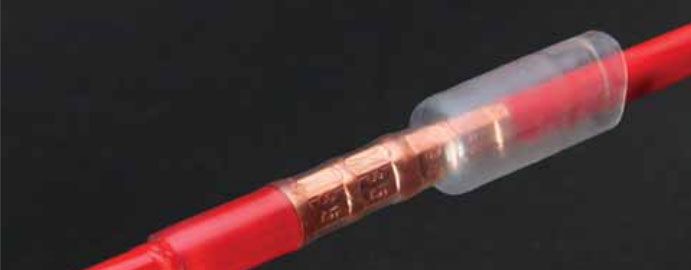
They are very convenient to mark the ends of the cable, if you follow the old rules for the color designation of phases. It is enough to put individual pieces on the end of the core.
For phases A-B-C buy Y (yellow) - Z (green) - R (red). 
But according to the new GOST fA-fV-fS, they correspond to the colors K (brown) -Ch (black) -C- (gray). Here you will have to use transparent tubes, or buy on order. 
There is also an original way out using multi-colored adhesive tape, on top of which a transparent thermal tube is applied. So the phases will be marked according to the new rules. 
If you do not need a color designation of phases, then take black ones. They are cheaper, and the quality of insulation is the same.
This is due to the specifics of the technological process. After each run of the same color, the screw is cleaned from old material. And this just affects the cost. 
There are also two-tone products of yellow-green color. They are for ground wires. 
When you want to see and control contacts after installation, a transparent tube will help you in this matter. Just be careful. Transparent will no longer be non-flammable products. Since the addition of flame retardants always leads to a change in color.
To apply inscriptions and mark wires, a piece of paper with numbers and symbols is often inserted under transparent tubes. After shrinkage, an excellent indelible marking is obtained. Thus, you can specify the brand of the cable, its cross section, what it feeds, and much more.Therefore, the properties of self-extinguishing and transparency are not compatible here.
True, in this case, it is better to heat the transparent heat shrink with a hairdryer, and not with a burner. Otherwise, you can accidentally damage the inscription itself. 
There are also semi-conductive heat shrinks and leveling electric field strengths.
But all the same, electrical insulating ones that are familiar to us are most often used. They use a material with high electrical insulating properties and have high electrical strength. Moreover, the higher this electrical strength, the greater the voltage class they are designed for: up to 1kv-10kv-35kv.
Despite the fact that heat shrink tubing was invented in the last century, it is still an innovative product in the electrical market. You can select and order sets of thermotubes for yourself.
For secure connection isolation electrical wires several types of materials can be used. These include the classic insulating tape made on the basis of dielectric polymers. But recently, heat shrink tubing / couplings have gained particular popularity. They are easy to install and have good performance.
Definition and specifications
Outwardly, they resemble a plastic insulating layer. But that's where their similarities end. Heat-shrink sleeves (TF) are designed to create a reliable layer of protection at the junctions of electrical conductors.
The principle of using TF is quite simple - it is installed on top of power cable until the moment of joining the current-carrying conductors. After their connection, the shell is placed over the joint. In this case, the edges of the coupling must be on the cable insulation. Further, with the help of an industrial hair dryer or a gas burner, the temperature on the surface of the TF is increased, as a result of which the diameter of the product decreases and its surface is compressed with the junction of the leads.
This principle of installation became possible due to the material used - a polymer based on polyolefin. Under the influence of temperature, the specific density of the material increases, as a result of which its dimensions decrease.
Main technical specifications thermal couplings are:

Couplings of various colors can be used for marking wires. Many models are processed adhesive composition inside. When exposed to temperature, it improves the insulating properties and serves as an additional factor in the reliable fixation of the sleeve on the surface of the wire.
Benefits of use and installation rules
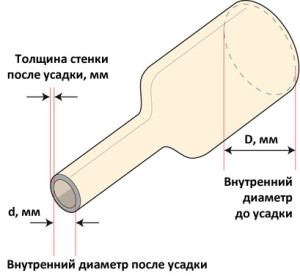 In addition to insulating electrical cables, heat shrink tubing is used when laying sewer and water supply pipes. However, their design differs from the above. Most often they consist of several components, the installation of which occurs in stages.
In addition to insulating electrical cables, heat shrink tubing is used when laying sewer and water supply pipes. However, their design differs from the above. Most often they consist of several components, the installation of which occurs in stages.
Subject to the installation technology, TF provides the following insulation qualities:
- mechanical strength. Due to the relatively high rigidity, a wire break at the installation site is practically excluded.
- Reliable protection against moisture. This reduces the likelihood of corrosion on the conductors, and also contributes to a lower rate of contact oxidation.
- Electrical insulation.
Installing heat shrink tubing is easy. To carry it out, you must first prepare the connecting wires. After stripping the ends from the insulating layer, the total length of the wiring is measured, where it is necessary to install the TF. For stranded wires it is best to use a complete kit, which has tubes of various thicknesses. It is selected according to the diameter of each cable. After compression, the diameter of the TF should be less than the cross section of the drive. For example, for a core with a thickness of 2.5 mm, a coupling with a diameter of 3 mm with a KU of at least 2 is needed.
Each of the cable components must be insulated separately. For example step by step instructions you can see the order of insulation of the 3-wire wire.
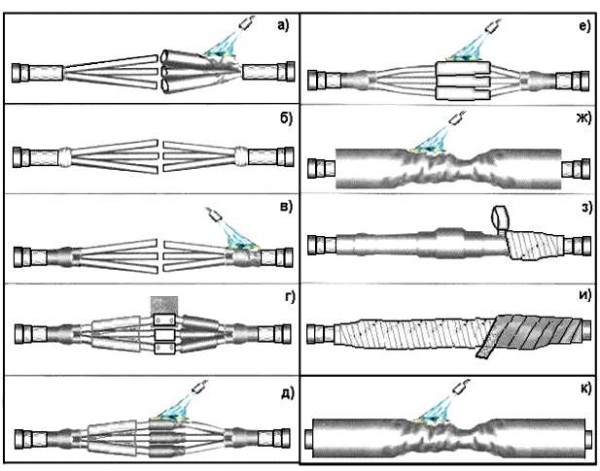
After completing the work, each of the sections is checked for tightness and tightness of the coupling to the cable.
The cost of TF directly depends on their type, size and configuration. The price of the 1st set with products of various diameters will be from 600 to 1300 rubles. This is the cost of a professional set of European production. Piece sales are rare. On average 1 m.p. will cost from 30 (2.5 mm) to 90 (35 mm) rubles.
When choosing, you should pay attention to the geometric dimensions of the product, wall thickness and color coding. The shrinkage factor should also be taken into account.
?
Heat shrink tubing is a tube made of polymer materials that shrinks in diameter after being heated. The adhesive underlayer secures the tube to the wire or cable. The tube can also be produced without an adhesive sublayer. The process that combines wire or cable and heat shrink tubing is called insulation.
What is the purpose of heat shrink tubing?
Heat shrink tubing is used to replace insulation, to protect against external influences, to insulate and mark pipes. Heat shrink tubing is an excellent way to protect electrical wires and cables in aggressive environments, such as water, oil, acid, as well as protection from external negative factors. environment. Heat shrink tubing is an alternative to conventional insulation methods and can be used in a wide variety of applications.
Why polyolefin tubing the best choice from the entire range of heat shrink tubing?
Polyolefin heat shrink tubing is a popular choice among all heat shrink options because polyolefin is flame retardant and has good chemical, electrical and physical performance. In general, polyolefin heat shrink tubing is a reliable product, manufactured to customer specifications with guaranteed quality. Heat shrink tubing is available in a variety of designs for a variety of applications. Polyolefin heat shrink tubing is an excellent choice for automotive applications. However, depending on the specific application, other heat shrink tubing specifications may be more suitable for your requirements.
Is it difficult to work with heat shrink tubing?
No, in most cases, heat shrink tubing is very easy to work with and install.
Heat shrink tubing is available in a huge variety of sizes and colors. Work does not require serious training and high responsibility, expensive equipment. Only the gloves and tools specified in the instructions are needed.
What are the benefits of using heat shrink tubing?
In addition to providing added strength and heat resistance, heat shrink tubing also provides perfect protection and will not come off after a certain amount of time or improper use - unlike electrical tape.
What are the important parameters to consider when choosing?
The maximum diameter of the cable or its knot and the temperature allowed for operation are important parameters to consider when choosing a heat shrink tubing. Since the parameters of different TUT tube manufacturers vary greatly, it is necessary to study the production process, crosslinking and properties of the raw material used for the production of heat shrink, as well as the final product characteristics, shrinkage coefficient and other points.
What are the tube shrinkage ratios HERE?
The shrinkage ratio indicates the ratio of the diameter of the heat shrink at the time of delivery and the diameter of the heat shrink at the time of full shrinkage after heating. Quantitatively, how many times the tube shrinks.
2:1 - In this case, the heat shrink tubing will become half the diameter of its original size when heated.
3:1 or 6:1 - Heat shrink tubing is three to six times larger at the time of delivery, respectively, than when fully shrunk.
By the way, the moment of complete shrinkage of the tube is stipulated everywhere, it is better to shrink the tube not to the maximum possible size, but by a maximum of 30-60%. This condition gives the best shrinkage result.
How to choose the right size of heat shrink tubing?
Choice right size heat shrink tubing depends on the accuracy of your measurements of the insulated material. Use accurate instruments to measure the smallest and the greatest value diameters of cable connections, diameters of wires, steel pipes that you intend to insulate. Choose heat shrink tubing that is twenty to thirty percent larger than your largest measurement. This difference is sufficient for free tension on the insulated surface. Also make sure the heat shrink tubing has a high enough shrink ratio to get a tight crimp for the smallest diameter you intend to insulate. Finally, when buying heat shrink, you need to take 10-20% more length, because the heat shrink tube decreases not only in diameter, but also in length when heated! This quality is called "longitudinal shrinkage" and, depending on the diameter, the coefficient of longitudinal shrinkage increases.
Hosted by the company
For right choice heat-shrinkable tube, it is necessary to take into account a large number of parameters depending on the conditions of its further operation as part of the equipment complex. The most important technical parameter any heat shrink is its diameter. Incorrectly selected tube diameter can lead to damage during shrinkage or during operation, preventing full use of all the possibilities of a heat-shrinkable tube. In the most innocuous case, the heat shrink tube simply will not fit on the shrinkable product. Properly selected tube is the key to reliable and durable operation of the equipment.
For the correct selection of the diameter of heat shrink, you need to follow a few simple rules:
1. The minimum diameter of the product (object) on which it is planned to shrink the tube must be at least 10% larger than the minimum internal diameter of a fully shrinkable heat-shrinkable tube in a free state.
Comments: This is very important, because if this condition is not met, the heat shrink tube will not fit the product well, the elastic compressive forces holding the heat shrink will be small, the tube may very loosely adhere to the surface of the product and even slip off it.
The optimal result is achieved when the diameter of the product to be insulated is larger than the diameter of the shrink tube by 20-40%. At these values, the heat-shrinkable tube will fully provide the characteristics of mechanical and electrical strength, durability, and temperature resistance inherent in it.
If the diameter of the insulated product is more than 50-70% of the minimum internal diameter of a fully shrinkable heat-shrinkable tube in a free state, then such situations are allowed provided that the product is not operated at temperatures close to the maximum design temperatures for this type of heat shrink tubing. Otherwise, at high operating temperatures (from + 90 to + 125 ° C), the heat-shrinkable tube may break due to the fact that the elastic compression forces exceed its tensile strength. It can also get worse performance characteristics tubes.
A tube rupture can also occur at the time of shrinkage, especially at a shrinkage temperature that exceeds the recommended one, so the shrinkage of tubes on such large products should be carried out slowly, at the lowest possible heating temperature.
2. The maximum diameter of the product (object) on which it is planned to shrink the tube must be at least 10% less than the inner diameter of the heat shrink tube before shrinking.
This rule is dictated primarily by the very possibility of stretching an unshrinkable heat shrink tube onto an object before shrinking, so as not to damage the tube itself. For products with complex surface relief, this parameter should, if possible, be increased to 20-30%.
In addition, if the internal diameter of the tube before shrinkage is only slightly larger than the diameter of the product, it may be damaged during shrinkage or subsequent operation at elevated temperatures. (See comment to the first rule).
Addition: Most heat shrinkable tubing has a 2x compression ratio. This is usually enough to select the right size of heat shrink for almost any product. However, there are cases when the insulated object (part) has a complex surface relief with large differences in diameters, for which it is impossible to pick up a tube so that all recommendations are followed.
For example, you need a reliable waterproof insulation of the area between a thin cable and a thick connector attached to it. We have to face a choice: either the tube will not tightly compress the surface of the cable, or we will not be able to pull the tube onto a thick connector!
An example of a simple calculation:
It is required to shrink an insulating heat-shrinkable tube onto a 10 mm round conductive busbar operating at room temperature. We have tubes of the following diameters (before/after shrinkage): 20/10 mm, 19/9.5 mm, 18/9 mm, 16/8 mm, 13/6.5 mm, 12/6 mm, 11/5.5 mm, 10/5 mm.
Since we have no temperature restrictions, we are guided by the rules of 10%. Tubes 10/5 and 20/10 are immediately discarded. In the first case, we will not be able to pull the tube onto the tire, and in the second case, after shrinking the tube, its diameter will be more than 10 mm and it will not be able to compress our product.
According to Rule 1, the inside diameter of a fully loose-fit tube must be at least 10% smaller than the tire diameter, i.e. 9 mm or more. This value does not correspond to tubes 20/10 mm and 19/9.5 mm.
According to rule 2, the inner diameter of the tube before shrinkage must be at least 10% larger than the diameter of the tire, i.e. not less than 11 mm. Thus, all remaining tubes: 18/9 mm, 16/8 mm, 13/6.5 mm, 12/6 mm, 11/5.5 mm are formally suitable as insulation for our tire.
If we take into account the additional recommendation that the most optimal is the case when the diameter of the shrinked tube is 20-40% less than the diameter of the insulated product, then the optimal diameter of the tube after free shrinkage should be from 6 to 8 mm.
Thus, the best solution for insulating our tire would be 16/8 mm, 13/6.5 mm and 12/6 mm tubes. And which one to choose is up to you based on their availability, required color, availability, economic feasibility, because smaller diameter tubes are usually cheaper.





